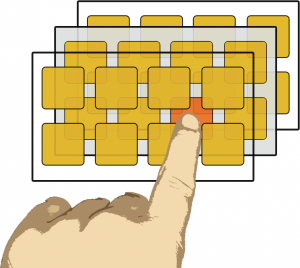3D displays are becoming more and more ubiquitous. While 3D displays cost roughly the same as their 2D counterparts, the understanding of how the 3rd dimension can be utilized for interaction is still limited. We explore different applications scenarios and mechanisms to exploit the 3rd dimension for interaction.
Using Eye-Tracking to Support Interaction with Layered 3D Interfaces on Stereoscopic Displays
 In this paper, we investigate the concept of gaze-based in- teraction with 3D user interfaces. We currently see stereo vision displays becoming ubiquitous, particularly as auto- stereoscopy enables the perception of 3D content without the use of glasses. As a result, application areas for 3D beyond entertainment in cinema or at home emerge, including work settings, mobile phones, public displays, and cars. At the same time, eye tracking is hitting the consumer market with low-cost devices. We envision eye trackers in the future to be integrated with consumer devices (laptops, mobile phones, displays), hence allowing the user’s gaze to be analyzed and used as input for interactive applications. A particular chal- lenge when applying this concept to 3D displays is that cur- rent eye trackers provide the gaze point in 2D only (x and y coordinates). In this paper, we compare the performance of two methods that use the eye’s physiology for calculating the gaze point in 3D space, hence enabling gaze-based inter- action with stereoscopic content. Furthermore, we provide a comparison of gaze interaction in 2D and 3D with regard to user experience and performance. Our results show that with current technology, eye tracking on stereoscopic displays is possible with similar performance as on standard 2D screens.
In this paper, we investigate the concept of gaze-based in- teraction with 3D user interfaces. We currently see stereo vision displays becoming ubiquitous, particularly as auto- stereoscopy enables the perception of 3D content without the use of glasses. As a result, application areas for 3D beyond entertainment in cinema or at home emerge, including work settings, mobile phones, public displays, and cars. At the same time, eye tracking is hitting the consumer market with low-cost devices. We envision eye trackers in the future to be integrated with consumer devices (laptops, mobile phones, displays), hence allowing the user’s gaze to be analyzed and used as input for interactive applications. A particular chal- lenge when applying this concept to 3D displays is that cur- rent eye trackers provide the gaze point in 2D only (x and y coordinates). In this paper, we compare the performance of two methods that use the eye’s physiology for calculating the gaze point in 3D space, hence enabling gaze-based inter- action with stereoscopic content. Furthermore, we provide a comparison of gaze interaction in 2D and 3D with regard to user experience and performance. Our results show that with current technology, eye tracking on stereoscopic displays is possible with similar performance as on standard 2D screens.
Evaluating Stereoscopic 3D for Automotive User Interfaces in a Real-World Driving Study
This paper reports on the use of in-car 3D displays in a real-world driving scenario. Today, stereoscopic displays are becoming ubiquitous in many domains such as mobile phones or TVs. Instead of using 3D for entertainment, we explore the 3D effect as a mean to spatially structure user interface (UI) elements. To evaluate potentials and drawbacks of in-car 3D displays we mounted an autostereoscopic display as instrument cluster in a vehicle and conducted a real-world driving study with 15 experts in automotive UI design. The results show that the 3D effect increases the perceived quality of the UI and enhances the presentation of spatial information (e.g., navigation cues) compared to 2D. However, the effect should be used well-considered to avoid spatial clutter which can increase the system’s complexity.